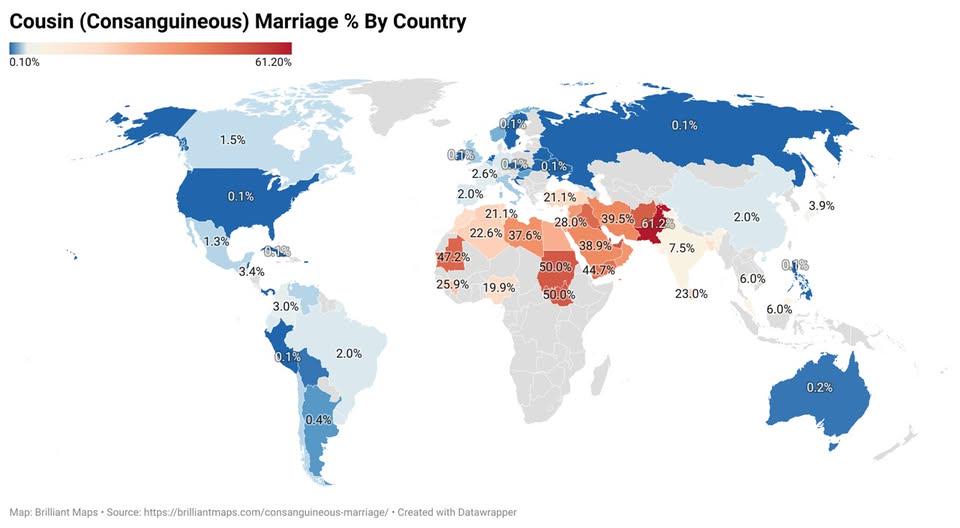Cousin Marriage Percentage by Country Map


David Chen
Data Visualization Specialist
David Chen is an expert in transforming complex geographic datasets into compelling visual narratives. He combines his background in computer science ...
Geographic Analysis
What This Map Shows
The "Cousin Marriage Percentage by Country Map" visually represents the prevalence of consanguineous marriages across various nations. Consanguineous marriages, defined as unions between individuals who are closely related, often bring forth intricate cultural, social, and biological implications. This map highlights the percentage of such marriages in different countries, revealing a fascinating tapestry of traditions and beliefs surrounding familial unions.
Deep Dive into Cousin Marriages
Cousin marriage is a practice steeped in history and culture, and it varies significantly across the globe. In many societies, marrying a cousin is seen as a means of preserving family ties and ensuring that wealth and property remain within the extended family. Interestingly, this practice is most prevalent in certain regions, such as the Middle East, North Africa, and parts of South Asia. In these areas, statistics show that cousin marriages can account for as much as 20% to 50% of all marriages.
Research suggests that cousin marriages can lead to a variety of outcomes, both positive and negative. On the one hand, they can strengthen family bonds and create a sense of community; on the other hand, they can increase the risk of genetic disorders among offspring. The genetic implications are particularly significant, as recessive genetic conditions may manifest more frequently in children born to closely related parents. Studies estimate that the risk of congenital anomalies in children from cousin marriages could be as high as 4-6%, compared to 2-3% in the general population.
What's fascinating is that while some cultures embrace cousin marriages wholeheartedly, others actively discourage them. For example, in many Western countries, such unions are often viewed with suspicion, and legal restrictions may even exist in some places. This cultural dichotomy raises important questions about societal norms and values surrounding marriage. Why do some cultures promote cousin marriages while others prohibit them? The answer often lies in historical, religious, and social contexts.
The map illustrates these cultural variations vividly. For instance, countries like Pakistan and Afghanistan report high percentages of cousin marriages, often exceeding 50%. In contrast, countries such as the United States, where such marriages are less common, might show less than 1%. This stark contrast invites further exploration into how migration patterns, globalization, and changing social attitudes influence marriage practices today.
Regional Analysis
Looking closer at the map, we can identify distinct patterns across regions. In the Middle East, countries like Saudi Arabia and the United Arab Emirates showcase high rates of cousin marriages, often linked to tribal customs and social structures that value familial loyalty and inheritance. Here, cousin marriages are not only common but often preferred, as they are believed to strengthen alliances between families.
In contrast, North African countries such as Egypt and Morocco also demonstrate significant percentages of consanguineous marriages, influenced by similar cultural traditions. Interestingly, these practices may vary even within the same country based on urban versus rural settings, with rural populations generally exhibiting higher rates of cousin marriages.
Moving to South Asia, nations like India and Bangladesh reveal a complex picture. In India, certain communities actively practice cousin marriages, especially among Muslims and some Hindu castes. However, other communities may reject such practices, leading to a patchwork of marriage traditions across the country.
In Europe, the prevalence drops dramatically. Countries like France and Germany have low rates of cousin marriages, reflecting broader societal trends that favor diverse marriage practices. Here, cousin marriages often face legal restrictions, which further contributes to their rarity.
Significance and Impact
Understanding the dynamics of cousin marriages is crucial for several reasons. Firstly, it sheds light on cultural practices that define social structures in various countries. Moreover, it raises important health considerations regarding genetic risks associated with consanguinity. As societies continue to evolve, the implications of cousin marriages may become even more pronounced, particularly as globalization alters traditional practices.
Moreover, current trends indicate a gradual shift in attitudes toward cousin marriages, especially in urban areas where exposure to diverse cultures is more common. This could lead to a decline in consanguineous marriages over time, as younger generations might seek partners outside their familial circles.
In conclusion, the "Cousin Marriage Percentage by Country Map" serves as a vital tool for understanding the intricate interplay between culture, genetics, and societal norms. As we move forward, it will be interesting to observe how these practices adapt and transform in our ever-changing world. Have you noticed how marriage norms have shifted in your area? Such changes reflect broader societal evolutions and highlight the rich tapestry of human relationships across the globe.
Visualization Details
- Published
- October 8, 2025
- Views
- 40
Comments
Loading comments...